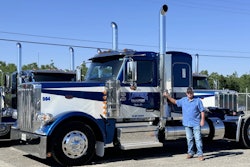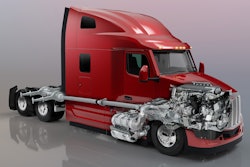Semi-truck tractors can operate in commercial service for more than 15 years. I’ve seen a 30-year-old Peterbilt Model 372 cabover running in my town. Freight train engines can operate for more than 50 years. Wabtec has a business refurbishing them in volume. I’ve randomly surveyed the age of trailers in a few yards and found they can easily exceed 20 years. The ubiquitous shipping containers seem to last decades, although not necessarily as intended for carrying freight. Some are refurbished into homes, or on-site static storage.
Freight assets seem to be like LEGOs. LEGO started manufacturing their plastic bricks in 1958. A Million Little Bricks, published in 2012, states there are at least “sixty-two LEGO bricks for every human living on Earth.” The forward of that book includes, somewhat conveniently for me, a picture of a LEGO semi-truck and trailer.
It’s now 2024, so I expect the exponential growth of LEGO demand has continued and that ratio is now much more than 62 per person. A typical single kit may have hundreds of pieces, so the easiest way to become “above average” is just to buy one kit, if your ego needs that boost.
The thing with LEGOs is they seem to last forever. I’m not aware of any significant effort to recycle LEGOS, although there is a huge market for reselling them as they get used over and over again in downstream purposes.
Kind of like tractors, trailers, containers and trains.
It’s perhaps a subtle point, but freight assets get resold, reused and repurposed all the time, just as LEGO builders repurpose their bricks over time from a model of a space ship to one of a truck. There are used LEGO stores, with bins holding thousands of bricks just waiting for some creative user to make them valuable again in some new, imaginative endeavor.
Just like trucks.
When J.B. Hunt buys a brand-new Freightliner sleeper for hauling 53’ dry van trailers 600 miles a day in a long-haul application, they have no idea what that truck will be doing 10, 12, 15 or more years later. It’s very likely that highway flyer will have been owned a couple times by downstream users that likely used them in urban short haul, drayage, for bulk materials like gravel, hauling farm products, or even converted them into straight trucks by adding a body. I saw a sleeper truck reconfigured as a dump truck driving around Dallas. I love looking at pictures of the drayage trucks in line waiting to leave port facilities. It’s always a motley collection of new and old day cabs and sleepers — like a truck museum.
The deal is that every new truck built by Paccar, Volvo, or whoever, will most likely have multiple duty cycles over its life. That first buyer gets the joy of configuring it “just right,” like Goldilocks, but every buyer after that is choosing from available pre-configured stock. And often it’s a matter of supply and demand. If there is no supply, they will take whatever they can get and use it, because they have to.
The arrogance of that first buyer is somewhat tempered by the fact that residual value is important. That first buyer has to care about the second buyer, where the market is trending, and the state of the economy in four or five years. Will they be able to sell their used truck at the premium they expect or will they have to sacrifice residual value just to move the unit out of their fleet?
The future is easy to predict. Just read the endless predictions daily in the news. What is hard is accurately predicting that future. Pre-buyers ahead of the 2007 model year had no idea that the economy would implode in 2009’s Great Recession. Truck market wizards had no great market insights ahead of the COVID pandemic, and even fewer accurate guesses during it. No one predicted that supply chains would make new trucks almost impossible to buy, making old trucks worth their weight in gold.
It’s 2024. What are your model year 2025 vehicles going to be worth in five years? Who is going to buy them? How about in 2035?
Tough questions, right?
What if you invest in a booming technology today that becomes obsolete in time? Will the market find a use for those obsolete vehicles? Or will they be stuck in your fleet forever because you can’t afford to sell them?
I have a box full of my family’s old telephone technology. It has things going back to a “princess” touch-tone hardline phone. It includes flip cell phones that did nothing more than make calls. It includes PDA, personal digital assistants, and an endless stream of increasingly more sophisticated “smart” phones. I often think the “smart” was the manufacturers’ programmed obsolescence requiring me to buy a new phone every few years.
To borrow a thought from Douglas McArthur, old trucks never die, they just get repurposed. Where will the market go in the future? Will new trucks be owned longer?
I suspect that the latest zero-emission and near-zero-emission vehicles are more purpose built for specific duty cycles. But supply and demand may force these vehicles to be creatively repurposed into new roles by downstream owners.
Another theory I’ve suggested is that trucks will become first-owner commodities, destined for the salvage yard after the first owner can no longer afford to maintain them.
We may see both of these situations impacting the used truck market in the next decade.
I took advantage of the 2009 Cash-for-Clunkers government program to buy a new vehicle, trading in a 10-year-old one. Some grant programs today require destroying the vehicle in exchange for obtaining the incentive. I expect we may see a growth in these kinds of incentive programs to help combat a rapid depreciation of assets driven by the pace of innovation.
In the past, there were times in the market where out of date trucks wound up being wholesaled to overseas markets; barges full of trucks headed to South American and other markets. Will we see that again? Is that the future of used trucks, to be dumped in foreign markets?
Like LEGOs, trucks have long lives. I’m pretty sure my home has some LEGOs that have traveled through more than a few hands over the years, becoming something new and useful that was not planned when they came out of their first box.
Will future trucks be that lucky? Or will they be destined to the salvage yards at an early age through obsolescence?













